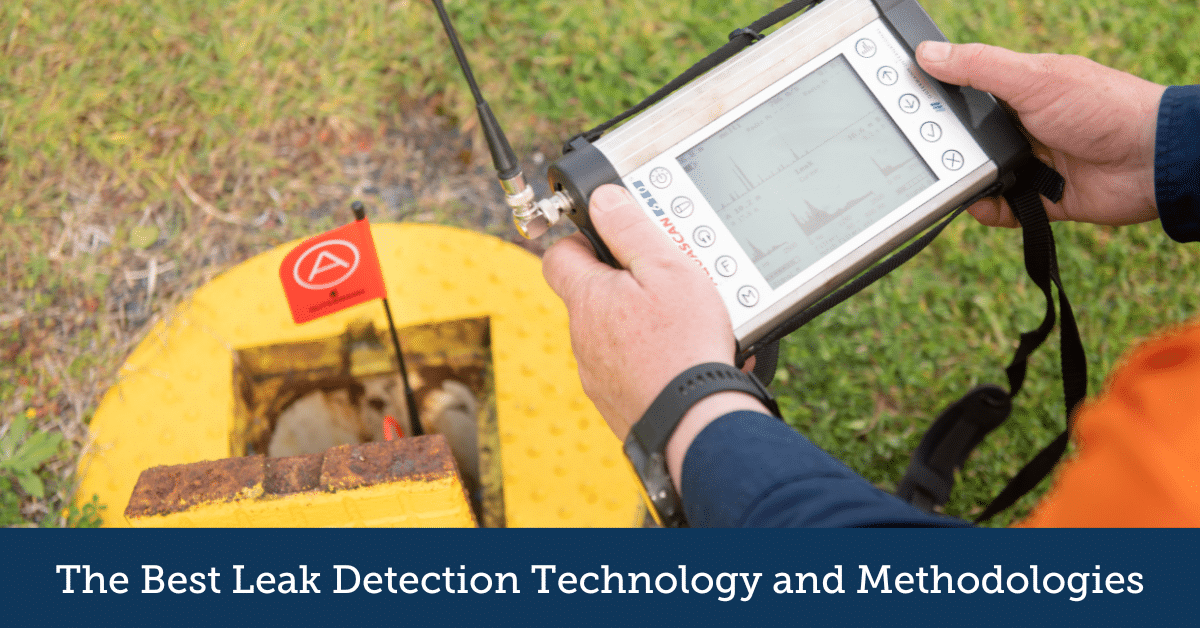When it comes to finding leaks in water supply networks, a range of acoustic leak detection technology is required to achieve successful results.
Organisations often overlook the need to couple this technology with skilled field teams. Professional field technicians can correctly use the technology and apply it to the situation to succeed. Success is finding all leaks within a specific part of the supply network (such as DMA) and providing diggable locations with pinpoint accuracy. Achieving both these steps not only leads to a reduction in non-revenue water in the specific area, but it also means lower repair costs from minimised excavation and repair efforts.
This blog post highlights the best leak detection technology and methodologies for finding leaks in Australia and New Zealand. With over 20 years of experience finding leaks in municipal water networks, Aqua Analytics is well-positioned to help water utilities reduce their leakage and operate more efficient systems.
The topics covered in this post are:
Acoustic listening sticks
These devices allow skilled operators to identify the distinctive acoustic signal of water escaping a pipe under pressure. Acoustic listening sticks are a leak detection technology commonly used during active leak detection survey work or when undertaking site assessments to determine the presence of, or potential location of, a leak. And while in some countries overseas, they persevere with manual listening sticks to find leaks, our experience demonstrates the need to utilise electronically amplified listening sticks for the best results.
Most leak detection equipment providers manufacture these devices, including Sewerin, HWM, Fuji-Tecom and Gutermann. The cost of these devices can vary from AUD 1500-3500 per device, and the quality ranges considerably.
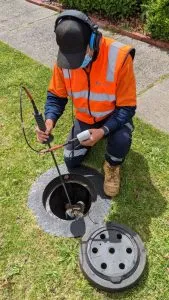
Correlating acoustic noise loggers
Acoustic noise loggers have been in the leakage toolbox for over two decades. Initially, loggers were supposed to replace skilled technicians, and the early iterations would provide a binary output, usually obtained from drive-by radio collection. The intent was to have these more permanently deployed. However, water authorities or leak detection contractors would often revert to a “lift and shift” model that saw the devices move as frequently as daily (once they had collected data from the previous night).
More recently, and coinciding with the evolution of mobile communication technology, these devices have become correlating and are sending data via traditional cellphone network infrastructure. Some of the latest versions use NarrowBand-Internet of Things (NB-IoT), a standards-based low power wide area (LPWA) technology developed to enable a wide range of new IoT devices and services. NB-IoT significantly improves the power consumption of devices, system capacity and spectrum efficiency. In the context of water supply networks, NB-IoT has helped with communication below ground into chambers with cast-iron lids or similar.
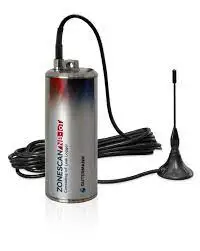
These devices send data daily, and their associated smart water software platforms enable multi-point correlation, and leak locations are immediately provided for repair teams to action. It is important to remember that an accurate GIS is always essential to ensure asset location and distances are correctly input into correlation calculations.
Gutermann is a leader in correlating noise loggers and was an early adopter of the NB-IoT standard. Ovarro also has correlating loggers, including the option of using hydrophones, which assist with monitoring and detection of leaks larger diameter trunk mains. These devices are typically AUD 1500 each for accelerometers and up to AUD 10,000 for devices with hydrophones.
Leak noise correlators
Skilled water network technicians utilise leak noses correlators to pinpoint leaks with confidence. Leak noise correlators get deployed by leakage technicians when they are unsure of the exact leakage location, for instance, when a similar noise on two appurtenances 150 meters apart.
Accelerometer sensors are deployed on the pipe on either side of the suspected leak location, and the pipeline diameter and material are entered into the correlator computer. Mathematical algorithms determine the exact location of specific noise profiles on the pipe. They corr elate the noises that reach both sensors and measure the time delay to travel along the pipeline from the leak location to each sensor.
In 1979, Palmer Environmental developed their first leak noise correlator collaborating with the Water Research Council. This device was enclosed in an orange metal case and was heavy and complicated. It was so large that it would often fill the entire storage space in a van and get refined every few years.

Despite manufacturer assurances, capabilities on PVC and PE pipelines continue to be sporadic at best. Essentially, the devices rely on the ability to ‘hear’ the leak at the two sensor locations to provide an accurate output on leakage location. Leak noise correlators cost approximately AUD 15,000 to 25,000 and regularly firmware upgrades are available from manufacturers.
Ground microphones
Often viewed as the favourite tool in the “leak detection toolbox”, a ground microphone is usually the final leak detection technology an operator uses before reporting a leak for repair (or discounted as no-leak). The device allows a custom ‘foot’ to be used above a pipeline, on concrete or bitumen surfaces, to listen to the sound generated. The sound of a leak on a pipeline underground will reverberate up through the soil and ground and be detectable above the pipeline.
A ground microphone may get used where water is seen visibly escaping through a road surface and pinpointing is required, or following a leak noise correlation to confirm (or otherwise) the leak location.
The devices are available from a range of leak detection equipment manufacturers and cost AUD 4,000 to 8,000 depending on required features and complexity.
Free-swimming technologies for trunk mains
Large diameter trunk mains experience acoustic propagation issues similar to PVC and PE reticulation mains. The sound generated by leaks doesn’t travel any significant distance to allow detection of all leaks on large diameter pipes using surface-mounted or water column monitoring devices. To find all leaks on big pipes, we need to change the leak detection methodology and take the sensor to the leak sound. The leak detection technologies that have become trusted in the last decade for detecting leaks on trunk mains often require a free-swimming device to be inserted into the pipeline.
Free-swimming devices collect an acoustic profile throughout the pipeline and can determine the location of all leaks (including those down to 0.1 litres per minute). The acoustic dataset and tracking data are combined to pinpoint leak locations accurately. Pure Technologies has offered free-swimming devices for over ten years, and more recently, they have also become available from Aganova. The use of these devices requires specialised trained crews, and the costs for trunk main leak detection are high compared to surface-based acoustic solutions. That said, due to the high level of water loss or consequence of failure on these large diameter mains, the cost is often easily justified by water authorities.
Active leak detection survey methodology
An active leak detection survey is a snapshot of leakage in a specific DMA, or sometimes whole towns, at one particular point in time. This task is an essential aspect of water loss management projects. Skilled teams of water network technicians move through the area systematically and listen for leaks, noting locations of interest before pinpointing and reporting for repair. When carrying out an active leak detection survey, technicians will leverage the entire leak detection technology toolbox.
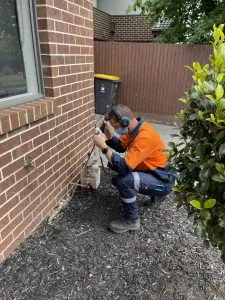
At Aqua Analytics, we always work in two-person teams, primarily for health and safety reasons, but secondly for improved quality outcomes. This methodology allows us to deploy a skilled technician to either side of the water main to listen on all available hydrants, valves and property service connections along the entire water supply.
There is a range of psychological reasons why two-person teams outperform 2X one-person teams, and clients who engage this technique see outsized performance outcomes. Clients who engage low-cost service providers for active leak detection frequently find that leakage in specific areas of the network doesn’t reduce. Several contributing factors lead to this, including poor equipment quality, lack of competent training and quality management issues such as “ghost surveys” (marking off a pipeline as complete, when zero sounding occurred).
Real-time leak reporting and data integration
There are four pillars in leakage management for water distribution networks are pressure management, speed and quality of repairs, active leakage control, and asset management. To address the ‘speed and quality of repairs’, we see it as essential to report leaks in real-time and incorporate leak location data into enterprise asset management systems of water utilities. Faster reporting leads to more timely repair, which ultimately results in lower levels of leakage.

The Aqua Analytics team can report on their smartphones or field tablets, using custom GIS-centric software (automatically pulling attributes such as Asset ID numbers, DMA details, etc.), which can then incorporate into systems like IBM Maximo.
Paper forms are outdated and lead to other errors and longer leak run-times. Third-party data collection apps, such as Fulcrum or Formsite, are often not integrated into GIS or EAM systems. Data can end up in a siloed environment where limited value is created for the broader benefit of a non-revenue water program. Seamless data transfer into the enterprise environment is critical to successful leakage reduction projects.
The importance of safety when conducting leak detection work
Workplace health and safety is critical for Aqua Analytics, and we are focused on ensuring our teams can go home to their families at the end of each day. Most of our clients share this perspective and have a no-compromise stance when it comes to safety on their projects.
Good safety management is an investment — an investment in your people.
Working in two-person teams when completing active leak detection is a critical aspect for us, which has a secondary benefit of improved quality outcomes due to the ability to cross-check work. Field technicians are less likely to perform “ghost surveys” when working alongside a colleague, and generally, it is known to improve morale.
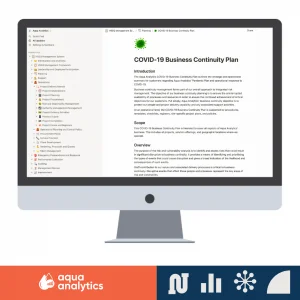
Conclusion
There is no silver-bullet technology to solve water loss or non-revenue water challenges in water networks. It takes dedication, great people and a sufficient budget to cover the completion of tasks to a high standard. While disruptive technology is attempting to find a silver bullet for water leak detection, at the current time, utilities who turn a blind eye to trained and skilled operators will see their leakage rates increase. The very nature of water networks, being buried and out of sight and in such substantial lengths, means that knowledgeable boots-on-the-ground personnel will always have a place to add considerable value to operations.
At Aqua Analytics, we are brand agnostic for water main leak detection technology. We utilise equipment from all major suppliers, including Gutermann, HWM, Fuji-Tecom and Ovarro. When coupled with a custom GIS-centric reporting platform, we give our clients an advantage in addressing their non-revenue water loss management.
To learn more or set up a complimentary consultation, contact us today.
